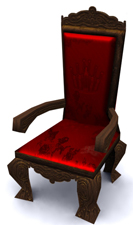
 Have you ever been to a job interview and felt completely overwhelmed when you sat in the “hot” seat? Have you ever felt so nervous that you were oozing buckets of sweat even before your interviewer asked you those tricky intricate questions? Well, it may not be your fault for feeling like this. It may have something to do with the cunningness of your interviewer. It is likely that your interviewer may have arranged his office furnishings to raise his own status and power, and, in doing so, lowered yours. Just look at the chairs around your office and then look at the executive ones and you’ll see the difference.
Have you ever been to a job interview and felt completely overwhelmed when you sat in the “hot” seat? Have you ever felt so nervous that you were oozing buckets of sweat even before your interviewer asked you those tricky intricate questions? Well, it may not be your fault for feeling like this. It may have something to do with the cunningness of your interviewer. It is likely that your interviewer may have arranged his office furnishings to raise his own status and power, and, in doing so, lowered yours. Just look at the chairs around your office and then look at the executive ones and you’ll see the difference.
Here’s how it works…
Chair Size:
The height of the back of the chair raises or lowers a person’s status, and the high-backed chair is a well-known example. The higher the back of a chair, the greater the power and status of the person sitting in it. Kings, queens, dictators, popes etc… always have ridiculously pronounced chair backs to show the minions who is in charge. Accordingly, the senior executive follows suit, to show the employees who is in charge, and they also give you a low back chair, just in case you don’t know your place.
Chair Accessories:
Swivel chairs have more power and status than fixed chairs, allowing the user freedom of movement when he is placed under pressure. Fixed chairs allow for little or no movement, and this lack of movement is compensated for by body gestures that can reveal a person’s attitudes and feelings. Also, if you have ever been in an interview sitting on a chair with no arm rests, you will know how uncomfortable it feels not knowing what to do with the two large lumps of meat hanging from your torso. To sum up, chairs with arm rests, those that lean back, and those that have wheels are far superior in terms of power, than those that do not.
Chair Height:
The acquisition of power using height can also be manipulated in the world of the chair. Some advertising executives are known for sitting on high backed chairs that are adjusted for maximum height, while their visitors sit opposite, in the competitive position, on a sofa or chair that is so low that their eyes are level with the executive’s desk. When smoking was allowed in offices, another neat little trick was to have the ashtray just out of the visitor’s reach, which of course forces him to be inconvenienced when tapping his cigarette.
Chair Location:
Another common power play in the executive’s office is to place the visitor chair as far away as possible from the executive’s desk, into the “social” or “public” territory zone (as opposed to the “intimate” or “friend” territory zone). This further reduces the status of the visitor.
I can’t believe I’m writing an article about chairs. I should really do some more work instead of coming to the office and looking at people’s chairs. Anyway, time for lunch, so adios.
This is a guest post by Chris O’ Hara.
(It could be worse. They could confiscate your chair.)
Leave a Reply